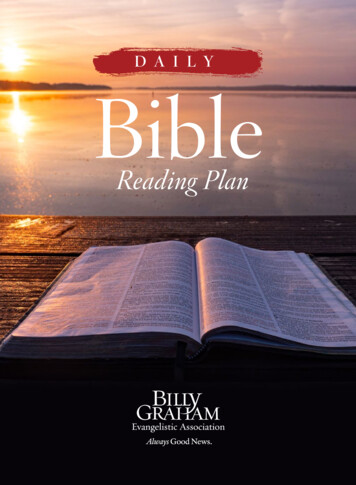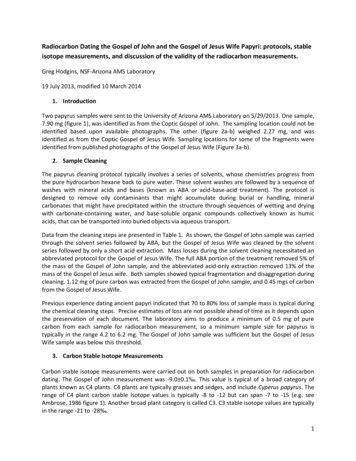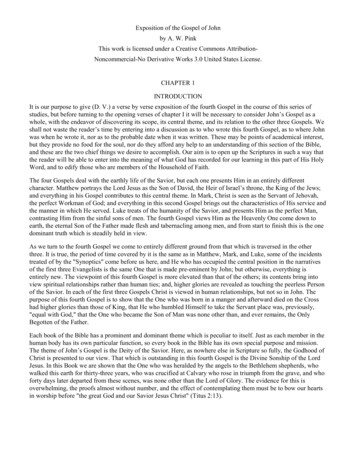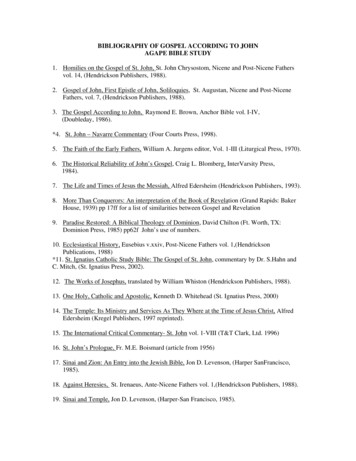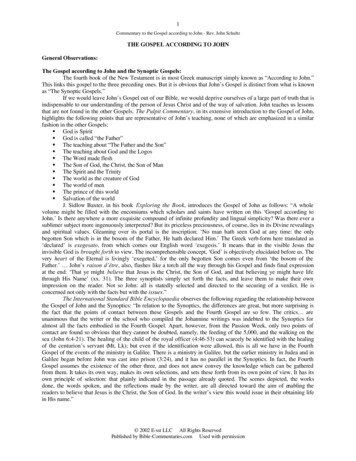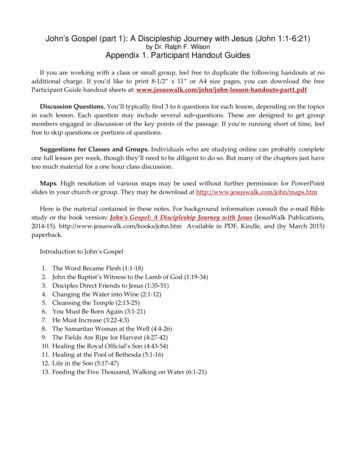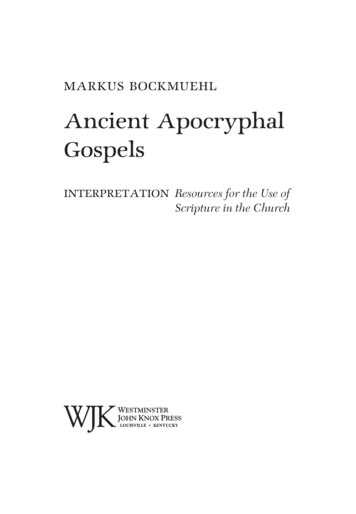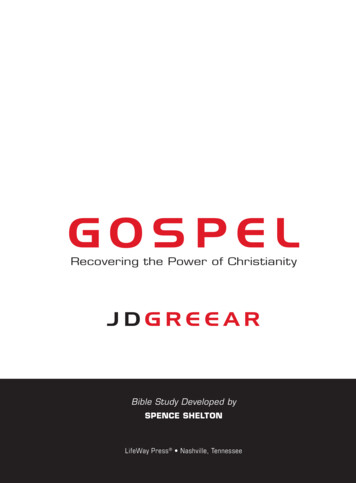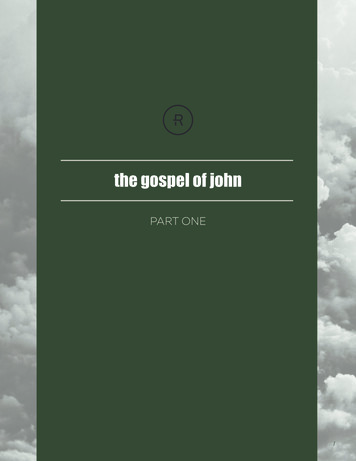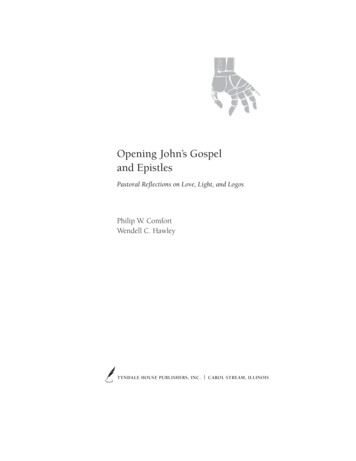
Transcription
Opening John’s Gospeland EpistlesPastoral Reflections on Love, Light, and LogosPhilip W. ComfortWendell C. HawleyTYNDALE HOUSE PUBLISHERS, INC.Opening.indd iii CAROL STREAM, ILLINOIS6/17/2009 6:31:30 AM
Visit Tyndale’s exciting Web sites at www.newlivingtranslation.com and www.tyndale.comTYNDALE, New Living Translation, NLT, and the New Living Translation logo are registered trademarks ofTyndale House Publishers, Inc.Opening John’s Gospel and EpistlesCopyright 1994, 2007 by Philip W. Comfort and Wendell C. Hawley. All rights reserved.John’s Gospel portion previously published as Opening the Gospel of John under ISBN 978-0-8423-4596-5.John’s Epistles portion previously published in Cornerstone Biblical Commentary, Volume 13, 1–3 John, underISBN 978-0-8423-8341-7.Opening John’s Gospel and Epistles first published in 2009.Cover illustration copyright 2009 by ImageZoo/Veer. All rights reserved.Designed by Erik M. PetersonUnless otherwise noted, Scripture quotations for John’s Gospel are from the Holy Bible, New InternationalVersion . NIV . Copyright 1973, 1978, 1984 International Bible Society. Used by permission of Zondervan.All rights reserved.Unless otherwise noted, Scripture quotations for John’s Epistles are from the Holy Bible, New LivingTranslation, copyright 1996, 2004 by Tyndale House Foundation. Used by permission of Tyndale HousePublishers, Inc., Carol Stream, Illinois 60188. All rights reserved.Scripture quotations marked NRSV are from the New Revised Standard Version Bible, copyright 1989 bythe Division of Christian Education of the National Council of the Churches of Christ in the United States ofAmerica. Used by permission. All rights reserved.Scripture quotations marked TLB are from The Living Bible, copyright 1971 by Tyndale House Foundation.Used by permission of Tyndale House Publishers, Carol Stream, Illinois 60188. All rights reserved.Scripture quotations marked NKJV are from the New King James Version . Copyright 1982, Thomas NelsonV is a trademark of Thomas Nelson, Inc.Inc. Used by permission. All rights reserved. NKJVScripture quotations marked NEB are from The New English Bible, copyright 1970, Oxford University Press,Cambridge University Press.Scripture quotations marked NASB are from the New American Standard Bible , copyright 1960, 1962, 1963,1968, 1971, 1972, 1973, 1975, 1977 by The Lockman Foundation. Used by permission.Scripture quotations marked TEV are from the Good News Bible, Today’s English Version, copyright 1966,1970, 1971 American Bible Society. Used by permission. All rights reserved.Scripture quotations marked NJB are from The New Jerusalem Bible, copyright 1985 by Darton, Longman &Todd Ltd. and Doubleday & Co., Inc.Library of Congress Cataloging-in-Publication DataComfort, Philip Wesley.[Opening the Gospel of John]Opening John’s Gospel and Epistles / Philip W. Comfort and Wendell C. Hawley.p. cm.First work originally published: Opening the Gospel of John. Wheaton, Ill. : Tyndale House, c1994. 2ndwork originally published: Cornerstone biblical commentary. Carol Stream, Ill. : Tyndale House Publishers,c2005- c2009 .Includes bibliographical references.ISBN 978-1-4143-3153-9 (sc)1. Bible. N.T. John—Commentaries. 2. Bible. N.T. Epistles of John—Commentaries. I. Hawley, Wendell C.,date. II. Title. III. Title: Cornerstone biblical commentary.BS2615.53.C66 20092009021515226.5′07—dc22Printed in the United States of America157Opening.indd iv1461351241131020916/17/2009 6:31:30 AM
PR AISE FOR THE FIRST EDITION OFOPENING THE GOSPEL OF JOHN“The approach is unique—scholarly notes for the serious students, sermonthoughts for the preachers and teachers, and practical devotional truths forevery believer. That’s the kind of balance I like!I especially appreciate the way the authors have handled the symbolismin John’s Gospel. John was a poet-theologian-evangelist, and they’ve donea splendid job bringing out all three aspects of his writing. Commentatorswho approach John’s Gospel only as a theological treatise miss so many of thebeautiful ‘asides’ that John has put there.The new believer and the most seasoned saint will both find enlightenmentand nourishment in the book. Best of all, they won’t have to struggle through alot of academic obstacles to get to the treasures. I’m recommending this book.”Warren W. Wiersbe, D.D.Bible Teacher“The unique format will prove highly useful to scholars, students, underscholars, and Sunday school teachers alike! I enthusiastically recommend it!”Harold L. Willmington, D.Min.Dean, Liberty Home Bible Institute“An excellent and insightful work. It opens the Gospel of John to the studentin a fresh and helpful manner.”R. C. Sproul, Ph.D.Professor of Systematic Theology“C. S. Lewis observed, ‘Any fool can write learned language, the vernacularis the real test.’ This commentary passes the ‘test,’ for its authors have openedprofound treasures of John with laser accuracy and brilliance. A book for thosesharing the ‘light of life.’ I am very enthused about this book.”R. Kent Hughes, D.Min.Senior Pastor Emeritus, College Church, Wheaton, IL“This is a splendid and very helpful book on John’s Gospel. Combining perceptive historical background materials, keen exegetical insights, practical lifeapplications, pertinent illustrations, and suggested preaching helps, the authorshave produced a rich and valuable study for serious Bible scholarship, bothtextual and interpretive. The authors do not dodge the problem of difficultpassages, but deal fairly with them and their interpretations. Presentation ofvarying views are carefully drawn. Any time spent in studying this volume willbe fully repaid. This is a book that pastors and Bible students will want to own.”William F. Kerr, Th.D.†Former Dean, PAC RIM Bible College & SeminaryOpening.indd i6/17/2009 6:31:11 AM
“Here is a solid truckload of top-class expository material. Preachers andteachers, rejoice!—and buy your copy at once! You will not regret theinvestment.”J. I. Packer, D.Phil.Professor of Theology, Regent College“Even though I’ve read the Gospel of John many times, it took on a new freshness as I read Opening the Gospel of John. This will be a ‘must book’ for everyonewho wants to teach or preach the Gospel of John.”Bernie MayWycliffe Bible Translators“Every teacher looks for a commentary that provides historical background,textual insights, and practical applications in a form easily grasped. Thisexcellent resource does all of it beautifully.”J. Allan Petersen†Family Concern“The authors have produced a valuable study of John’s Gospel that shouldbe of great value for ministers preparing sermons on John or for laypeoplepreparing Bible studies. Opening the Gospel of John tackles the Gospel in significant sections, highlights the theme of each section, lists the major points,discusses key terms, and provides a running commentary on the verses. Thewhole is very practical. Readers will find many useful applications to today’sevangelical church.”James M. Boice, Th.D.†Former Pastor, Tenth Presbyterian Church,Philadelphia, PA†DeceasedOpening.indd ii6/17/2009 6:31:29 AM
ContentsDedication viiPreface ixJOHN’S GOSPELIntroduction to the Gospel of John 3JOHN 1:1-18JOHN 1:19–2:12JOHN 2:13-25JOHN 3:1-21JOHN 3:22-36JOHN 4:1-54JOHN 5:1-47JOHN 6:1-71JOHN 7:1-52JOHN 8:12-59JOHN 9:1-41JOHN 10:1-42JOHN 11:1-57JOHN 12:1-50JOHN 13:1-30JOHN 13:31–14:31JOHN 15:1–16:4JOHN 16:5-33JOHN 17:1-26JOHN 18:1-40JOHN 19:1-42JOHN 20:1-31JOHN 21:1-25Opening.indd vThe Prologue: Jesus, the Word Become Flesh 15The Beginning of Jesus’ Ministry 27Jesus Clears the Temple in Jerusalem 41Jesus Reveals the Need for Regeneration 47John the Baptist Extols the Superiority of Jesus 55Jesus, the Life-Giver 64Jesus, the Divine Healer 80Jesus, the Bread of Life 92Jesus, the Smitten Rock 106Jesus, the I Am 118Jesus, the Sent One, the Light of the World 128Jesus, the Shepherd 137Jesus, the Resurrection and the Life 148Jesus, Received Yet Rejected 159Jesus, Master and Servant 170Jesus: The Way, the Truth, and the Life 179Jesus, the True Vine 194Jesus and the Spirit 204Jesus’ Intercessory Prayer 213Jesus’ Arrest and Trials 222Jesus’ Crucifixion and Burial 233Jesus’ Resurrection 246The Epilogue: Jesus’ LastResurrection Appearance 2576/17/2009 6:31:30 AM
APPENDIX TO JOHN’S GOSPELJohn 7:53–8:11The Woman Caught in Adultery268BIBLIOGRAPHY 271JOHN’S EPISTLESIntroduction to 1 John 2751 JOHN 1:1-41 JOHN 1:5-101 JOHN 2:1-21 JOHN 2:3-111 JOHN 2:12-171 JOHN 2:18-271 JOHN 2:28–3:31 JOHN 3:4-101 JOHN 3:11-181 JOHN 3:19-241 JOHN 4:1-61 JOHN 4:7-211 JOHN 5:1-51 JOHN 5:6-121 JOHN 5:13-21The Prologue 287Living in God’s Light with the Community of Believers 291Experiencing the Ministry of Jesus, the Advocate 295Living in the Light Means Loving Fellow Believers 297The Community of Believers Affirmed as aSpiritual Family 301Identifying the False Believers and the True 304Being Prepared for Christ’s Return 309Recognizing What Kind of Life Prospers the Fellowship andWhat Contradicts It 311Love for the Community Members, a Sign ofDivine Life 316Maintaining a Relationship with God by Being Faithfulto Him and Living in Christ 320Community Fellowship Protected by Watchfulnessfor Deceivers 323God’s Love Expressed in Community Love 327Overcoming the World 333Discerning Truth from Falsehood and KeepingEternal Life 336Conclusion: Helping the Wayward Returnto the Fellowship 341Introduction to 2 & 3 John 3492 JOHN 1:1-32 JOHN 1:4-112 JOHN 1:12-133 JOHN 1:1-23 JOHN 1:3-123 JOHN 1:13-15Greetings 355Live in the Truth 358John’s Final Words 363Greetings 365Caring for the Lord’s WorkersJohn’s Final Words 373367BIBLIOGRAPHY 375GENERAL APPENDIX: MANUSCRIPTS 379Opening.indd vi6/17/2009 6:31:30 AM
DEDICATIONThe authors are very appreciativeof the insightful suggestionsof Mrs. Beth Bergman,whose editorial touch enhancedthis work immeasurably;and the support of Phil’s wife,Georgia, andWendell’s wife, Nancy, whoseencouragement and affirmationnever ceased.Opening.indd vii6/17/2009 6:31:30 AM
PrefaceFor six years, early on Wednesday mornings, we laid the Gospel of John openbefore us to study it verse by verse. We asked God to open our spiritual eyes tosee Jesus afresh, and he was faithful time and again to reveal living truth to us.As the years went on, we decided to expand our studies to include John’s epistlesand to share our thoughts with others—especially those who teach and preachfrom them.One of the authors, Philip Comfort, has taught this Gospel at various collegesand churches during the past twenty years. The other author, Wendell Hawley,has preached this Gospel in many churches and army services as a pastor and achaplain. Our goal in writing this book was to combine our efforts in producing a book on John’s writings that would provide the teacher and preacher withexegetical and homiletical insights. To this end, each section has an introductionand/or exposition, a preaching focus (not a fully developed sermon, but a “seedstarter” or “pump primer” devotional suggestion), a section on key words andphrases, exegetical comments on every verse, and textual notes. It is our prayerthat our readers will use this fresh resource, together with the text of the Bibleitself, to strengthen the believers’ living faith in Jesus Christ, the Son of God.Opening.indd ix6/17/2009 6:31:30 AM
The Gospel of JohnOpening.indd 16/17/2009 6:31:30 AM
IntroductionTHE AUTHORSHIP OF JOHN’S GOSPELIn a day when John’s authorship of the fourth Gospel is routinely challenged, itis important for teachers and preachers to know how to make a case for the wellfounded premise that the fourth Gospel was written by John the son of Zebedee,for he was both an eyewitness of Jesus and an apostle. We must be able to affirmfor our listeners and students that this Gospel is an eyewitness account withapostolic authority.Though John’s authorship is not explicitly stated anywhere in the Gospel, thetext itself points to his authorship. The writer of this Gospel, one of Jesus’ twelvedisciples, calls himself “the one whom Jesus loved” (13:23; 19:26; 20:2; 21:7, 20).From the synoptic Gospels we realize that three disciples were especially close toJesus: Peter, James, and John. Peter could not have been the author of this Gospelbecause the one who identified himself as “the one whom Jesus loved” communicated with Peter at the Last Supper (13:23-25), raced Peter to the empty tombon the morning of the Resurrection (20:2-4), and walked with Jesus and Peteralong the shore of Galilee after Jesus’ resurrection (21:20-23). Thus, someoneother than Peter authored this Gospel. And that someone could not have beenJames, for he was martyred many years before this Gospel was written (see Acts12:2). That someone must have been John, who shared a deep friendship withJesus. Most likely, it was also John who was “one of the two”—the one who, withAndrew (Peter’s brother), was the first to follow Jesus (1:35-40). Furthermore itseems probable that he was the one whose acquaintance with the high priest latergained him access along with Peter into the courtyard of the place where Jesuswas on trial (18:15-16). This eyewitness, “the disciple whom Jesus loved,” stoodby Jesus during his crucifixion (19:25-26) and walked with Jesus after his resurrection (21:20). This is that same disciple who wrote the Gospel that bears hisname (21:24-25). (See Westcott, who follows a similar line of reasoning to proveJohn’s authorship.)The question remains, Why didn’t John identify himself directly? Why, instead,would he call himself “the disciple whom Jesus loved” or “the/that other disciple”?The former expression seems a bit arrogant—after all, didn’t Jesus love the otherdisciples? Of course. But John wanted his readers to know that he had a specialOpening.indd 36/17/2009 6:31:30 AM
4Introductionrelationship with Jesus—not for the sake of boasting, but for the sake of affirming the trustworthiness of his testimony. As the Son “in the bosom of the Father”(1:18, NKJV) was the one qualified to explain the Father to mankind becauseof his special relationship with the Father, so John, who reclined on Jesus’ chest(13:23, see NLT mg), was qualified to explain Jesus and his message to readersbecause of his special relationship with Jesus. In this Gospel “the beloved disciple”or “the other disciple” is given a certain kind of preeminence: He is the first to follow Jesus (1:35-37); he is the closest to Jesus during the Last Supper (13:22-25);he follows Jesus to his trial (18:15); he alone of all the disciples goes to Jesus’ crossand is given a direct command from Jesus to care for Jesus’ mother (19:26-27);he outruns Peter to the empty tomb and is the first to believe in Jesus’ resurrection (20:1-8); and he is the first to recognize that it is Jesus appearing to them inhis Galilean visitation (21:7). If John had named himself in all these instances, hewould have appeared quite arrogant. Rather, he attempted to retain some humilityby referring to himself in the third person; at the same time, he probably expectedthe immediate circle of readers to clearly identify him as the apostle John and tobelieve in the validity of his written account.We also gather from early church history that this Gospel was attributed toJohn. Several of the early church fathers stated so with great conviction. Irenaeus,writing around AD 200, said, “John, the disciple of the Lord, he who had leanedon his breast, also published the Gospel, while living at Ephesus in Asia” (Heresies3.1.1). Irenaeus indicated that he had obtained his information from Polycarp (c.70–155), who was a disciple of John (and even quoted 1 John in his own epistlearound 120). Furthermore, Irenaeus cited Papias, a contemporary of Polycarp,as giving witness to the fact that John was the author of the fourth Gospel (ibid.,5.33.4). Other early (second- and early third-century) church fathers attributedthe fourth Gospel to John: Heracleon (the first known commentator on John,repeatedly quoted by Origen), Theophilus, Clement of Alexandria, Tertullian,Hippolytus, and Origen. And several second-century sources (whether orthodox, heterodox, or heretical) provide evidence for the existence of John’s Gospel:the Gnostic Basilides, The Gospel of Truth by Valentinus, Tatian’s Diatessaron, TheApocryphon of John, and The Gospel of Thomas. These sources show that John’sGospel, written at the end of the first century, was prevalent throughout theGreco-Roman world in the early second century.Since the time of Irenaeus, the church has given constant witness to the tradition that John wrote the Gospel while residing in Ephesus. Not until the pastcentury or so has the apostle John’s authorship been challenged. The gravestproblem with some of these challenges is that they undermine the eyewitnessaccount found in the Gospel; for in declaring that someone other than John theapostle, the son of Zebedee, wrote this Gospel, they take away the apostolic testimony. The writer of the Gospel clearly claims to have seen the Word incarnate(1:14), to have witnessed the Crucifixion (19:35), and, in fact, to have witnessedall the events recorded in the Gospel (21:24). The apostle John’s eyewitnessOpening.indd 46/17/2009 6:31:30 AM
Introduction5account is what authenticates this Gospel and gives us ground for believing itstestimony about Jesus Christ, the Son of God (see 20:31; cf. 1 Jn 1:1-4).Some scholars affirm the eyewitness account of the Gospel writer, but thendo not identify him as John the apostle. Who else could the eyewitness be? Allattempts at naming another person are unconvincing. Therefore, many of thesame scholars who reject the apostle John’s authorship feel compelled to namehim as the authority behind the Gospel but not the writer of it. (For more onthis, see J. A. T. Robinson’s Redating the New Testament, pp. 254–311, which aptlydefends the apostle’s authorship.)John’s eyewitness authorship of the fourth Gospel is repeatedly affirmed bythe historical and geographical accuracy of the text. For example, archaeologicaland related historical studies have verified John’s description of (1) the Samaritans—their theology, worship at Mount Gerizim, and the location of Jacob’s well;(2) the pool of Bethesda and accompanying details; (3) the theological themesassociated with the Jewish feasts and ceremonies current in Jesus’ day; and (4)details about Jerusalem itself—the pool of Siloam, Solomon’s portico (a shelter inwinter), and the stone pavement of Pilate’s praetorium. John’s descriptions reflectan accurate knowledge of Jerusalem prior to its destruction in AD 70. The samereporting accuracy was at work when John provided an eyewitness account ofJesus’ words, feelings, and miraculous signs.PLACE OF WRITINGReaders and students of John’s Gospel usually want to know the historical settingfor its writing. In order to provide this background, one may look at the earliest accounts of church history. Eusebius, the first church historian (after Luke),wrote Ecclesiastical History around 325, and he gives us a great deal of information about the composition of the fourth Gospel.Irenaeus said that John, the disciple associated with this Gospel, lived inEphesus (Heresies 3.1.1). Polycrates (bishop of Ephesus around 190) also saidthat John had lived in Ephesus (Eusebius’s History 3.31.3). Another tradition(provided by the Muratorian Canon) tells us that John wrote this Gospel at therequest of some of his fellow disciples and the elders of the church residing withhim in Ephesus. Clement of Alexandria affirmed the same: “Last of all John, . . .being urged by his friends, and inspired by the Spirit, composed a spiritual gospel” (ibid., 6.14.7). Most likely these “elders” or “friends” at Ephesus were themen who, at the conclusion of the Gospel, bore witness to the authenticity ofJohn’s narrative. We read in John 21:24 (NRSV), “This is the disciple who is testifying to these things and has written them.” To these words, the elders at Ephesusappended their testimony, “And we know that his testimony is true.”The final composition of John’s Gospel—including the epilogue (ch 21) andother editorial adjustments—could have taken place anywhere between AD 80and 100. Very likely the initial work—i.e., John’s preaching about Jesus’ life andOpening.indd 56/17/2009 6:31:30 AM
6Introductionteachings—began as early asof the Gospel.AD70, followed sometime later by an initial draftTHE WRITING AND PUBLICATION OF JOHN’S GOSPELAccording to Irenaeus, John “published” his Gospel, which most likely meanshe wrote it and had it reproduced into multiple copies for distribution to various churches. The Greek word exedoke, appearing in Irenaeus’s account (Heresies3.1.1), was used in ancient times to mean this kind of publication. Many portionsof the Gospel were probably first uttered by John through oral discourse, in homilies or teachings to the early believers about the life and sayings of Jesus Christ. Inthe first-century church, most of the Christians learned of the life and teachings ofJesus through oral transmission and catechisms; the written Gospels were a laterdevelopment, created to affirm and/or clarify the oral tradition (Luke 1:1-4).When the occasion arose for John to put his “sermons” into writing, he evidently composed a series of vignettes, each saturated with Jesus’ discourse,woven into a sequential narrative. The entire Gospel focuses on “the Word”—God’s expression to men, God’s explicator. First, Jesus, as the Word, came toexplain God to men; then John expounded on this exposition and formed it intoa series of teachings for the church. Thus, each passage in the Gospel of Johnis not only a historical narrative but a homily packed with spiritual instructionfor the believers of John’s time, as well as for believers throughout all time. Theauthor’s intention was to produce a document not of history, but of faith (see20:30-31). Yet John is very historical—historical in the sense in which history isconcerned not only with what happened but also with the deepest meaning ofwhat happened (Brown 1966).John must have also participated in publishing its final form. The antiMarcionite prologue to John says, “According to Papias, the dear disciple of John,in his five exegetical books, his Gospel was published and sent to the churchesby John himself during his lifetime.” In John’s day it was the customary practicefor an author to dictate his words to a scribe and then read over the manuscriptto make editorial adjustments.At that time it was common for books to be published in multiple copies.Prior to the first century, most books were published in the form of a papyrusroll. From the first century onward, more and more books, especially those containing Scripture, were published in the form of a papyrus codex. (The termcodex designates a book having a spine to which folded pages were stitched.)Christians used the codex almost exclusively for preparing copies of both Oldand New Testament books. Very likely, John’s Gospel was first published in several codices. Perhaps John (or the Johannine community) employed the use ofprofessional scribes in the great library at Pergamum (a city not far from Ephesus,where John wrote his Gospel) in making the publication. If he did not, then hewould have relied on the church community to make the publication.Opening.indd 66/17/2009 6:31:30 AM
Introduction7Very likely, John published a first edition of his Gospel and then another withan appended chapter at the end. Chapter 20 provides the first conclusion withan excellent colophon telling the reader why this book was written. Chapter 21 isclearly an addendum. It is possible that John added this chapter shortly after hewrote the Gospel and then published all twenty-one chapters in the first publication, but it is likely that John added chapter 21 some time after the first publication, in a second edition. There seems to be evidence that the Gospel of Johncirculated as a twenty-chapter Gospel and also as a twenty-one-chapter Gospeleven as late as AD 200 because two early papyrus manuscripts, P5 and P75, verylikely had only twenty chapters (see discussion at the end of ch 20). If, in fact, P5and P75 originally contained a Gospel of only twenty chapters, this would confirm the view that the Gospel of John was first published and circulated withoutthe epilogue. Sometime after the first publication, John added the epilogue andsent forth another publication. This publication superseded the first one—as isattested to by all other extant manuscripts. (See the appendix to Comfort’s Questfor the Original Text of the New Testament.)As was previously mentioned, tradition tells us that John wrote his Gospel atthe request of some of the elders of the church residing with him in Ephesus.Most likely these are the men who, at the conclusion of the Gospel, bore witnessto the authenticity of John’s narrative.THE CIRCULATION OF JOHN’S GOSPEL THROUGHOUTTHE MEDITERR ANEAN WORLDAs was noted earlier, John’s written Gospel was probably reproduced into multiple copies by the Johannine community (perhaps with the help of professionalscribes at Pergamum) and sent out to the churches in Asia Minor and beyond.This Gospel, as with the other three Gospels, usually circulated as a book of itsown, unattached to any of the other Gospels. It wasn’t until the third century thatthe four Gospels began to be collected into one volume.The fourth Gospel had widespread distribution in the second century and wasgenerally regarded as the work of John the apostle. The second-century churchfathers who read this Gospel and referred to it were Papias, Polycarp, Irenaeus,and Theophilus (of Antioch); the third-century church fathers who read John’sGospel and quoted it were Origen, Clement of Alexandria, Tertullian, Hippolytus, and Melito (bishop of Sardis).The Gospel of John was also popular among those who professed the orthodox Christian faith. Braun ((Jean Theol I) shows that John’s Gospel was acceptedin orthodox circles in Egypt, Rome, Syria, and Asia Minor from the early yearsof the second century. John was also popular among early Egyptian Gnostics.In the second century several Egyptian Gnostics, such as Basilides (who quotedJohn 1:9, according to Hippolytus), Valentinus (who wrote The Gospel of Truth),Ptolemaeus (who wrote a commentary on John’s prologue), and Heracleon (whoOpening.indd 76/17/2009 6:31:30 AM
8Introductionis the first one known to write a commentary on John’s Gospel), misused theGospel of John to support their views. This misuse involved flawed exegesis andprooftexting, more than textual tampering.The Gospel of John was also very popular in the second and third centuriesamong the Egyptian Christians. Several papyri containing portions of John havebeen discovered in Egypt, and many of these have been dated to the secondor early third centuries. The John Rylands Papyri, P52, containing portions ofJohn 18, has been dated from 110–125; Papyrus Edgerton 2, containing portions drawn from John, has been dated around 150; the Bodmer Papyrus II, P66,preserving almost all of John, has been dated around 175; the Bodmer PapyrusXV, P75, displaying John 1–15, has been dated around 200; the OxyrhynchusPapyrus, P90, containing portions of John 18 and 19, has also been dated around200. Some other Oxyrhynchus Papyri, such as P5 and P22, are early-thirdcentury manuscripts, as is the Chester Beatty Papyrus, P45.John’s Gospel enjoyed widespread distribution because of its universal appeal.It seems directed to the universal church composed of Jewish and Gentile believers. John had served the Jewish Christians in Jerusalem for many years (AD 30–70)and then later in life (probably after AD 70) ministered to the Gentile churchesin Asia Minor. Thus John ministered to both Jewish and Gentile churches andwould have been well received by both. Unlike Paul, whose commission tookhim to the Gentiles and away from the Jews, John had served both communities.Furthermore, so far as we know, John had not taken sides during the Jew/Gentilecontroversies described in Acts 15. His Gospel manifests a Jewish orientation,for most scholars readily point out that this Gospel was written by a PalestinianJew. Nonetheless, it retains a universal appeal. The Jewish Christians reading thisGospel would immediately see all the connections with the Old Testament; theGentiles would read this Gospel and immediately recognize that Jesus had cometo give life, light, and truth to the whole world.JOHN’S PRIMARY PURPOSE FOR WRITING HIS GOSPELAt the time John wrote this Gospel (anywhere from AD 70 to 100), the early Christians needed written documentation from Jesus’ eyewitnesses to confirm andclarify what they had been taught orally. Most likely, the immediate recipients ofJohn’s Gospel were the churches in Asia Minor (seven of which are also addressedin the book of Revelation), because John labored among these churches in thelatter part of his ministry. As with all the New Testament writings, the audiencehas extended far beyond those to whom the writings were originally directed.Nevertheless, it is important to put each book in its historical context.When John wrote his Gospel narrative, his aim was for the readers to keep onbelieving in Jesus as the Christ, the Son of God, and to keep on having life in hisname (20:31). His Gospel was written primarily to those who already believedyet needed their faith infused with a fresh breath of life and strengthened by aOpening.indd 86/17/2009 6:31:31 AM
Introduction9clear presentation of Jesus Christ, the Son of God. (The verb tense for believe, apresent subjunctive in the earliest manuscripts containing John 20:31, indicatesthat John wrote this Gospel to encourage ongoing faith, more than to produceinitial faith, though it can certainly do the latter quite well. The other verbalexpressions in John 20:31—“believing” and “have life”—are also in the present tense, emphasizing continual action.) John wrote his Gospel to encourage
Contents Dedication vii Preface ix JOHN'S GOSPEL Introduction to the Gospel of John 3 JOHN 1:1-18 The Prologue: Jesus, the Word Become Flesh 15 JOHN 1:19-2:12 The Beginning of Jesus' Ministry 27 JOHN 2:13-25 Jesus Clears the Temple in Jerusalem 41 JOHN 3:1-21 Jesus Reveals the Need for Regeneration 47 JOHN 3:22-36 John the Baptist Extols the Superiority of Jesus 55
